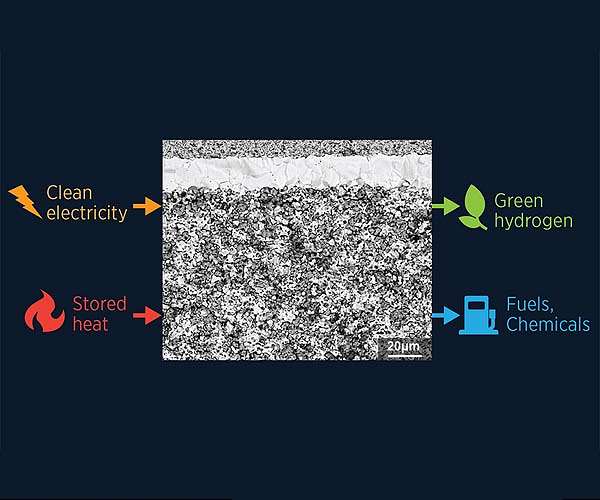Hexagonal perovskite oxides as advanced electrolytes for protonic ceramic fuel cells
by Riko Seibo Tokyo, Japan (SPX) July 9, 2024 In a remarkable advance in fuel cell technology, researchers at the Tokyo Institute of Technology (Tokyo Tech) have identified hexagonal perovskite-related Ba5R2Al2SnO13 oxides (R = rare earth metal) as promising materials with high proton conductivity and thermal stability. Their unique crystal structure and numerous oxygen vacancies enable complete hydration and efficient proton diffusion, making these materials ideal electrolytes for next-generation protonic ceramic fuel cells (PCFCs) that can operate at intermediate temperatures without degradation.
Fuel cells, which combine hydrogen and oxygen to generate electricity while producing only water and heat as byproducts, offer a clean energy solution. These cells consist of an anode, cathode and electrolyte. Hydrogen gas at the anode splits into protons (H+) and electrons. The electrons create an electric current, while the protons migrate through the electrolyte to the cathode, where they react with oxygen to form water. Most existing fuel cells are solid oxide fuel cells (SOFCs) that use oxide ion conductors as electrolytes. However, SOFCs require high operating temperatures, which can cause material degradation over time. To mitigate this, PCFCs that use proton-conducting ceramic materials as electrolytes are being investigated, as they can operate at lower, more controllable temperatures of 200-500 C. The challenge remains to find materials that exhibit both high proton conductivity and chemical stability at these temperatures . intermediate temperatures.
In a study published in the Journal of the American Chemical Society, a team led by Professor Masatomo Yashima of Tokyo Tech, in collaboration with researchers from Tohoku University, identified hexagonal perovskite-related oxides Ba5R2Al2SnO13 (R stands for rare earth elements Gd, Dy, Ho, Y, Er, Tm and Yb) as promising electrolyte materials. These materials exhibit a high proton conductivity of almost 0.01 S cm², significantly higher than other proton conductors at around 300 C.
“In this work, we discovered one of the highest proton conductors among ceramic proton conductors: the new hexagonal perovskite-related oxide Ba5Er2Al2SnO13, which would be a breakthrough for the development of fast proton conductors,” says Yashima.
The high proton conductivity of the material is due to its complete hydration in a very oxygen-poor crystal structure. This structure consists of octahedral layers and oxygen-poor hexagonal, close-packed AO3-d (h’) layers (A is a large cation like Ba+ and d represents the amount of oxygen vacancies). When hydrated, these vacancies are filled by oxygen from water molecules to form hydroxyl groups (OH-), releasing protons (H+) that migrate through the structure, improving conductivity.
The researchers synthesized Ba5Er2Al2SnO13 (BEAS) using solid-state reactions. The material showed a high level of oxygen vacancies (d = 0.2) and a fractional water uptake of 1, indicating full hydration capacity. In a wet nitrogen environment, the conductivity at 356 C was 2100 times higher than in a dry nitrogen environment. Fully hydrated it reached a conductivity of 0.01 S cm? at 303 C.
The atomic arrangement in the octahedral layers provides pathways for proton migration, further increasing conductivity. In simulations of Ba5Er2Al2SnO13-H2O, the motion of protons was studied in a 2+ 2+ 1 supercell of the crystal structure represented by Ba40Er16Al16Sn8O112H16. The protons in the octahedral layer showed long-distance migration, indicating fast proton diffusion.
“The high proton conductivity of BEAS is attributed to its high proton concentration and diffusion coefficient,” Yashima explains.
In addition to its high conductivity, BEAS is chemically stable at the operating temperatures of PCFCs. Tests under a wet atmosphere of oxygen, air, hydrogen and CO2 at 600 C showed no changes in composition and structure, indicating robust stability and suitability for continuous use without degradation.
“These findings open new avenues for proton conductors. The high proton conductivity via complete hydration and fast proton migration in octahedral layers in very oxygen-poor hexagonal perovskite-related materials would be an effective strategy for the development of next-generation proton conductors,” says Yashima. . With its exceptional properties, this material could lead to efficient, sustainable fuel cells with a lower temperature.
Research report:High proton conductivity in the octahedral layers of fully hydrated hexagonal perovskite-related oxides

